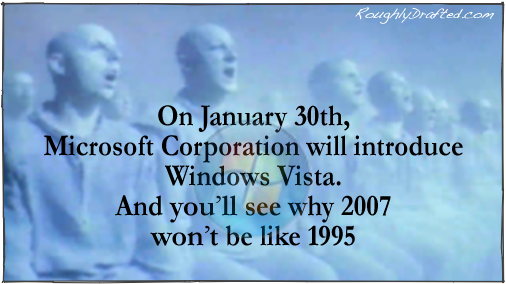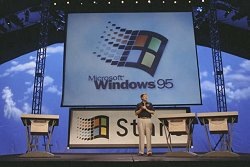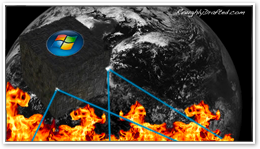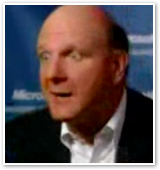

Windows 95 and Vista: Why 2007 Won't Be Like 1995
What if Microsoft threw a party, and nobody came?
Despite its best efforts to create excitement for Windows Vista at release parties held in a variety of retail stores this last week, nobody seems to care about the product.
Just over a decade ago, things went very differently at the release of Windows 95. Some people were reportedly so excited that they bought it without even having a computer to run it on.



What's killing Microsoft’s party this time around?
Look, It's Got A Start Button
Back in late 1995, Microsoft spent $300 million on a massive, worldwide campaign to introduce Windows 95. The company lit up the Empire State Building in red, yellow, and green Windows logo colors, draped Toronto's CN Tower with a 300 foot banner ad, and paid to distribute a million and a half free copies of the Times in London.
The official release party on Microsoft's Redmond campus brought in Jay Leno to host, and paid the Rolling Stones millions for the rights to use "Start Me Up" as the Windows 95 anthem.
Microsoft also produced a half hour TV infomercial, and hired huge teams of users to provide support for the new product. At CompUSA launch parties, Microsoft handed out copies of ”Windows 95 for Dummies.”
Windows 95 wasn't anything close to the Cairo Microsoft had promised back in 1991. Instead, it was just the latest version of MS-DOS running an improved version of the existing Windows graphical shell. Internally, it was called Windows 4.0.
Even so, Bill Gates described it as empowering technology that would herald in a new dawn of computing.
"Windows 95 is about unlocking more of the potential of computing," Gates said in a Microsoft press release. "We are moving into the next era of computing, with broader communications via e-mail and the online world, dazzling multimedia and games, and richer educational software. Windows 95 helps open up this new world. It makes computing easier and more fun, and will empower people and businesses to do more with computers than has previously been possible."
Windows 95 Reaction
Gates was stretching past the truth in his comments about ‘empowering people to do more than had been previously possible.’ He knew Windows 95 wasn't much of a release; his company had worked with IBM on a real operating system in the late 80s, which Microsoft abandoned in 1990 in favor of developing NT on its own.
Five years later, NT was still running late, and it didn't look like it could be adapted for home users anytime soon. Microsoft had to fudge an interim plan out of its existing Windows 3.x product, which was still based on MS-DOS.
As the Washington Post observed, "customers expecting Windows 95 to be a great technological leap forward may be disappointed. International Business Machines Corp. and Apple Computer Inc. already have operating systems on the market that sport the features – greater memory management, the ability to perform several tasks at once and enhanced user-friendliness – now being hailed in Windows 95."
The Post quoted Tim Breuer of IBM as saying, "Microsoft is delivering the same features we delivered seven years ago. We're moving on business as usual here."
Apple’s response was printed in full page ads in major newspapers:
C:\ONGRATLNS.W95
Hey This Is Not Cairo
And what about NeXTSTEP, the basis for Gates' vaporous Cairo announcements from nearly a half decade prior in 1991? Years before Microsoft even announced plans to copy NeXT with Cairo, NeXT had released advanced object oriented frameworks running on top of a modern Unix foundation.
NeXT frequently demonstrated features such as voice email, rapid application development, and modern graphics imaging. Gates was certainly aware that the future had already been delivered, and not by Microsoft.
Gates was also well aware that--even by Microsoft’s standards--Windows 95 was just reheated legacy garbage, particularly in comparison to what other companies had already delivered.
 Microsoft was hyping Windows 95 as something noteworthy and impressive, but everyone in the industry knew better.
Microsoft was hyping Windows 95 as something noteworthy and impressive, but everyone in the industry knew better. At the time, it was common to see bumper stickers saying "Windows 95 = Macintosh '89," making it puzzling that something widely recognized as a third rate product could rapidly gain market share.
The Big Mac Attack
Despite the casually indifferent attitude expressed by IBM, Apple, and others, Windows 95 turned out to be devastating for both OS/2 and Mac sales. Microsoft reported selling a million copies of Windows 95 within four days; a year later, it had sold 40 million copies.
On the PC, sales of rival operating systems from OS/2 to DR-DOS quickly dried up; NeXT had already given up on selling its NeXTSTEP product in the anti-competitive PC market prior to the launch of Windows 95, and set out to adapt its technology to power web servers instead.
Apple's hardware sales also took a huge hit. The company began its fall from a position as the top PC maker with 10% of the US PC market to its desperate condition in 1996 and 1997, when it reported losses of $836 million and then a billion dollars--although more than half of its losses in 1997 were costs related to buying NeXT.
So what was the factor that pushed adoption of Windows 95 a decade ago?
It wasn't good technology. CNET described Windows 95 as one of the biggest disappointments of 1996, writing, "Though it was hyped as a 32-bit powerhouse, many companies simply ignored it and stayed with Windows 3.1. And who could blame them? Plug and Play is often plug and pray and to make matters worse, Windows 95 often runs slower than a comparable Windows 3.1 system. And 32-bit or not, it still crashes. A lot."
It wasn't third party software makers. US News and World Report stated, "From a software publisher's point of view, releasing a Macintosh version makes good business sense. Production costs for Mac software are lower than those for Windows titles; less testing is required because there is a single standard for Mac hardware and software. And Macintosh owners buy 30 percent more software than their Windows counterparts."
IDC reported at the time that the average cost to develop and support Windows applications was 50% higher per dollar of revenue than the cost to develop for Mac, and that Macs generated almost 75% more software revenue per machine than Windows machines.
It wasn't an improvement in quality. JD Power and Associates had ranked Apple Macs first in reliability, dependability, and customer satisfaction.
It was the Windows Price Paradox. Microsoft didn't sell 40 million retail copies of Windows 95 at its $209 retail price to consumers wanting to buy its software.
At Windows 95’s debut in the third quarter of 1995, Microsoft reported selling 4 million OEM copies and 3 million Windows 95 retail copies. From then on, retail sales of Windows dropped to about a third the number of bundled OEM sales on new PCs.
Today, OEM sales represent 80% of Microsoft’s Windows profits. Few people buy Windows, they simply get it on their PC as an automatic sale, whether they want it or not.
Microsoft used its existing monopoly position to force hardware makers into exclusive licensing agreements that ensured an OEM copy of Windows 95 was sold with every new PC, and prevented any bundled sales of competing operating systems.
That forced competitors to market their software as a third party retail product competing against the already installed Windows 95, which appeared to be free to end users. There was effectively no real choice among PC operating systems. That left consumers with only the choice between a PC and a Mac.
Free Reign
Apple stumbled through a number of poor business decisions throughout the early 90s, leaving Microsoft with little effective competition. Under CEOs Michael Spindler and Gil Amelio, Apple:

-
•failed to market the Mac effectively
-
•failed to sell Macs in retail effectively
-
•provided poor and expensive software developer tools and support
-
•failed to deliver its own Mac software development
Microsoft on the other hand, was using PC manufactures to do its marketing and sales, provided much better support for developers, and wrote its own killer apps for Windows, principally Office.
A Perfect Storm
From the mid 80s to the mid 90s, Microsoft amassed fortunes as an application developer for the Mac. Even in 1996, Microsoft reported making more money from Office--$4.56 billion--than it did from all of its Windows sales combined--$4.11 billion.
Tying sales of Windows 95 to Office helped to boost sales of both. Microsoft pushed the new version of Office as a reason to buy Windows 95, and Windows 95 helped kill sales of rival applications, including the then standard WordPerfect and Lotus 1-2-3, neither of which were available or optimized for Windows 95 at its launch.
That series of events conspired to create a perfect storm funneling the lion's share of new application and PC operating system revenues toward Microsoft and away from all rivals.
The media was stunned that such a undistinguished product could have such remarkable market power. Many analysts concluded that Microsoft was simply being run by a brilliant visionary genius, and sold their souls into the eternal service of Microsoft.
Ship Now, Fix it Later
Throughout the second half of the 90s, Windows 95 was improved upon with a series of updates. The original "O" version of Windows 95 was nearly unusable, but updates in the 1996 "A" and later "B" versions made it workable.
Those updates were only installed on new PCs however, and were not made freely available to users stuck with the original version. The solution for many users was simply to buy a new PC. Further updates would require users to pay at regular intervals for new versions that got progressively worse.
Windows 98, a paid upgrade, was released in June 1998 at a simpler event at Fort Mason in San Francisco. It promised to deliver the Internet and the Push Buzzword to PC users; internally it was numbered Windows 4.1.
In 1999, Microsoft released another paid upgrade, Windows 98 Second Edition, which delivered more bug fixes and a new browser version. It also carried the Windows 4.1 major version number.
In 2000, Microsoft delivered more updates to home users in Windows ME, another paid upgrade internally designated as Windows 4.90. It was such a bad product many Windows users stuck with Win98.
Uptake of Windows ME was so bad that Microsoft was later forced to extend its end of life support for Win98. Windows ME was listed forth in PC World's list of the "Worst Tech Product of All Time," and was commonly referred to as "Mistake Edition."
What users really needed was the NT code Microsoft spent five years struggling to integrate into its DOS-based Windows 95/98/ME product. While Windows ME was a tragically bad product, Windows 2000--aka NT 5.0--worked pretty well; it had been released for business users the same year as Windows ME.
In 2001, Microsoft released Windows XP--aka NT 5.1--as a paid upgrade, revised version of Windows 2000 with all the support for games and odd hardware that had previously only been available on DOS-based Windows.
The Gates Illusion
The mystique of Bill Gates grew as Microsoft destroyed the competition in one industry after another, using products that in most cases weren't very remarkable.
By the release of Windows XP in 2001, Microsoft had swallowed up 98% of the OS market and had become proficient in using its market power to destroy emerging competition in web platforms, in Java development, and elsewhere.
IBM's OS/2 was gone, and Apple's Mac platform had only just recovered from free fall. Apple had spent five years adapting the NeXT technology it bought in the end of 1996 for the new Mac OS X. In 2001, had just released the first full version and first free update.
Even before XP was delivered, Microsoft announced it would:
Why 2007 Won't Be Like 1995
From 1996 to 2006, Microsoft's revenues jumped from $8.67 billion to $44.2 billion, and its net income jumped from $2.2 billion to nearly $12.6 billion. Despite enjoying huge net profit margins of 28.45%, Microsoft's profits to earnings ratio is down from .37 a decade ago to .25 today. Why are the company's profits slipping?
Efforts to deliver on its promises in Longhorn, mobile devices, consumer electronics, music and media have all been huge failures. PC sales have slowed down as consumers waited for the new Longhorn, delivered now over three years late as Vista.
Outside of Office, Windows, and server products, Microsoft's efforts in home, entertainment, and mobile devices lost a staggering $1.2 billion in 2006.
Over the last five years, Microsoft replayed the same type of illusions it delivered in the early 90s:
-
•technologies promised for Longhorn were dropped as features, just as Cairo had fallen apart a decade prior
-
•efforts to deliver music and media products were rejected by consumers in favor of Apple's iPod and iTunes
Software vs Hardware
One might imagine that demand for a new version of Windows should be higher now than it was a decade ago. There are some critical differences however. In 1995, Microsoft promised to turn the dumpy DOS PC into something rivaling a Macintosh at a fraction of the cost of buying a new Mac.
Today, PCs running Windows XP are serviceable, and there's no compelling reason for most users to pay hundreds of dollars for a software upgrade. Most users upgrade when they buy a new PC. Further, the price of Windows has jumped from $209 for a full version of Windows 95, to as much as $399 for the Ultimate version of Windows Vista.
Steve Ballmer wildly gesticulated about the iPhone's $500 price tag, but doesn't seem to grasp that the iPhone delivers more functionality than his own company's attempts with Handheld PCs at a much lower price.
The iPhone is also hardware device with a certain perceived value; customers who paid $500 for earlier generations of the iPod wouldn't have paid hundreds of dollars for a software MP3 player.
Likewise, how many shoppers who paid $800 for their PC will turn around and spring for a $300-400 software upgrade that offers some new flash, but really just makes their system run slower?
Ballmer probably didn't give the subject much thought, because his company can't figure out how to make money selling hardware, and is stuck trying to sell software to consumers.
The problem with that strategy is that consumers don't like to pay for software; they prefer to buy hardware.
It's very difficult to sell software to anyone apart from professionals, who see the value of buying software as a tool. Vista simply doesn't offer much beyond Microsoft's assurance that it fixes the security and usability problems in XP. The problem is it really doesn't, and introduces problems of its own, such as slower performance.
OMG Competition
Another critical difference new in 2007 is that Windows Vista now has effective competition. Apple made a number of major changes between 1997-2001 to bounce back as a retail and marketing powerhouse. It has shipped five major new revisions of Mac OS X since Microsoft last delivered Windows XP.
Windows watchers started comparing Longhorn with Apple's Mac OS X 10.3 Jaguar in 2004. When Longhorn never arrived, Microsoft's revised plans were compared with Apple's Mac OS X 10.4 Tiger in 2005.
Two years later, Vista is now largely being dismissed as Microsoft's version of Tiger, making it difficult to create excitement for it. It’s like the Zune, offering to match features of the almost two year old G5 iPod. Yawn.
Even worse for Microsoft, Apple is about to deliver Mac OS X 10.5 Leopard, which builds upon a system that is already known to not suffer from the nagging security, spyware, and viruses that plague Microsoft's products.
Turned Tables, Sticky Sales
On top of that, Apple is now selling NeXT's technology using Microsoft's own tricks: Apple's Mac OS X is only available on Macs. That means that anyone buying a Mac gets a copy of Mac OS X free, and shelling out $300 for a copy of Windows is only an option; an automatic sale for Apple, and a hard sell for Microsoft.
Oh, how the tables have turned.
It gets even worse for Microsoft however. Every new Mac buyer not only expands the Mac market at the cost of Windows, but does so at a greater than 1:1 ratio. Since Macs typically last longer than PCs, every Mac sold means multiple sales of PCs will never happen. Macs last for 4-5 years; typical PCs only 2. Every Mac sold takes out two or more unnecessary PCs, meaning fewer automatic sales of Windows at an accelerating pace.
Oh, and if you have a PC that is more than two years old, count yourself lucky. For every PC more than two years old, there are plenty of far more ancient Macs still in use.
Mac buyers are also more likely to buy a Mac in the future, making the allure of Mac OS X sticky. That's not the case with Dell or HP buyers, who are likely to buy whatever PC happens to be cheapest two years down the road.
Once you go Mac, you don't go back.
It's Not the Money
Bill Gates and Steve Ballmer, both of whom top the list of the world's richest individuals, are ready to retire and can't be too concerned about losing a few bucks to the Mac.
Lost revenue pales in comparison to how embarrassing its must be to have to suffer through the unveiling of their charlatan scams to deliver the world old, overpriced technology wrapped up in a frumpy me-too package.
Prior to Apple's purchase of NeXT, Steve Jobs was quoted in Triumph of the Nerds giving his impression of Microsoft's products:
"I guess I am saddened, not by Microsoft's success - I have no problem with their success, they've earned their success, for the most part. I have a problem with the fact that they just make really third rate products."
Since then, innovation at Apple under Jobs has demonstrated just how third rate many of Microsoft's products are in comparison.
If a company with a quarter the market valuation, a quarter the employees, and a sixth the profits of Microsoft can dethrone the company in its operating system development efforts, block its attempts to expand its monopoly into music and media DRM, and embarrass it in mobile development, how would Microsoft do on an equal playing field?
Blame Bad Management
Microsoft isn’t a bad entity made up of engineers working to hold back the technology available to consumers and businesses. It’s staffed by the same sort of brilliant engineers, developers, and marketers that work at Apple, or Google, or contribute to open source.
What gives Microsoft such an ill reputation for anti-competitive behavior and mediocre products is the faulty vision and blinding greed of its upper management, particularly Bill Gates and Steve Ballmer.
Together, they have done more to stifle new ideas and glut the market with bad products than any other force in our lifetime. Even worse, Gates and Ballmer ignored their incredible potential to use their monopoly position to usher in a wave of fantastic new technology, and instead saddled the world with more profiteering junk.
As Douglas Adams said, "The idea that Bill Gates has appeared like a knight in shining armour to lead all customers out of a mire of technological chaos neatly ignores the fact that it was he who, by peddling second-rate technology, led them into it in the first place."
Is there anything worthwhile at Microsoft apart from its monopoly positions in Office and Windows? What will happen to Microsoft as Mac OS X continues to eat into the premium and most valuable end of the desktop market, and Linux--backed by everyone from IBM to Oracle--eats into Microsoft's business and server markets?
I think I already know, but it will be fun to watch anyway.
Next Articles:
This Series


 |
|
 |
|
 Del.icio.us |
Del.icio.us |
 Technorati |
About RDM :
:
Technorati |
About RDM :
:

Monday, February 5, 2007









 Send Link
Send Link Reddit
Reddit NewsTrust
NewsTrust






